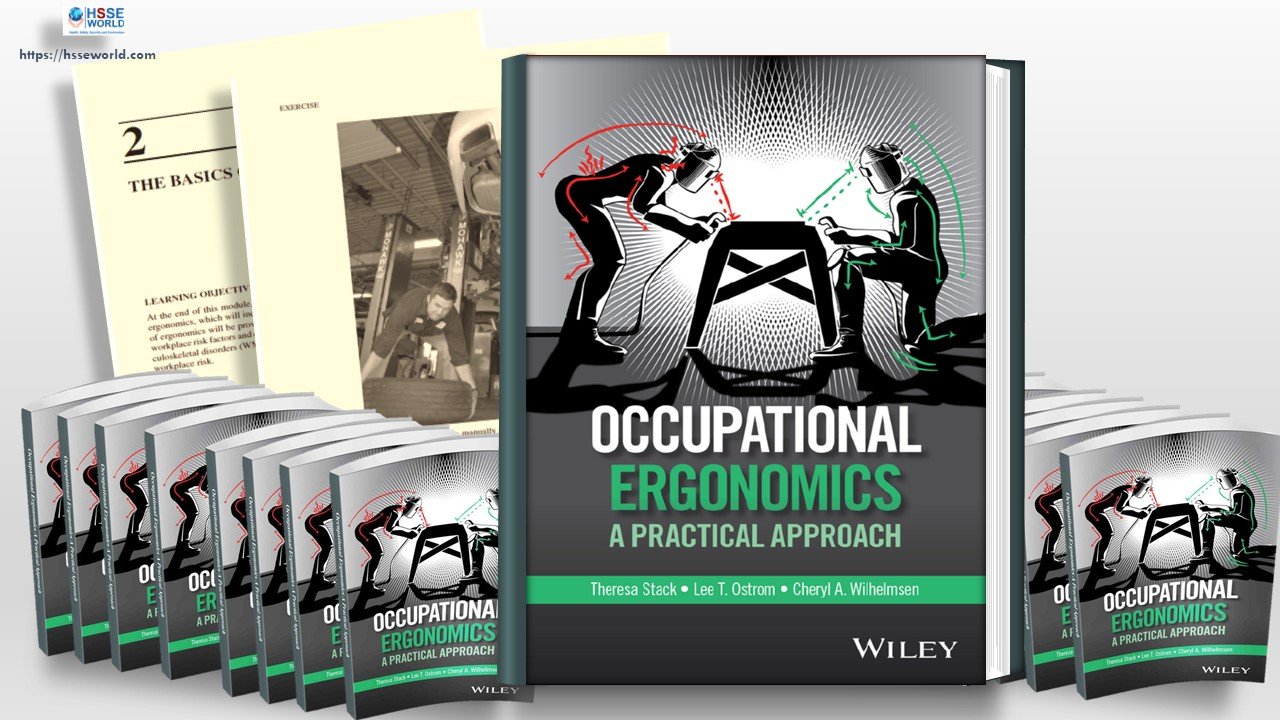Occupational Ergonomics A Practical Approach by Cheryl A. Wilhelmsen. The book contains all the important building blocks of occupational ergonomics it revisits the fundamentals of workplace ergonomics and takes you to step by step through more advanced workplace evaluations. The Book is a collaborative effort that merges engineering principles with practical applications to improve worker health, safety, and morale. It is packed with ergonomic evaluation tools and methods as well as well-crafted case studies to broaden the readers’ understanding of reducing physical risk factor exposure and increasing productivity.
Ergonomics is a fiel of study that involves the application of knowledge about physiological, psychological, and biomechanical capacities and limitations of the human
(Butterworth, 1974). This knowledge is applied in the planning, design, and evaluation of work environments, jobs, tools, and equipment to enhance worker performance, safety, and health. Ergonomics is essentially fitting the workplace to the worker.
Ergonomics seeks to prevent WMSDs by applying principles to identify, evaluate, and control physical workplace risk factors.
History of Ergonomics
Wojciech Jastrz ¸ebowski, a Polish biologist, coined the word “ergonomics” as the science of work in 1857 in a philosophical narrative “based upon the truths drawn from the Science of Nature.” The term ergonomics – er⋅go⋅nom⋅ics \,ûrg-go-’näm-iks\ – is derived from two Greek words, Ergon meaning work and Nomos meaning principles or laws. Jasterzebowis understood the human and economic impacts of the industrial revolution during a time when a society of farmers traded in their hoes for 14-hour days in factories, growing iron and steel in lieu of wheat and potatoes.

Factories brought people, processes, and power together like never before. A more commonly used definition of ergonomics today, as defined by one of the fathers of modern ergonomics Étienne Grandjean, is “fittin’ the work to the worker.”Ergonomics is an applied science combining various disciplines that cater to the special needs of humans and is a goal-oriented science that seeks to reduce or eliminate injuries and disorders, increase productivity and improve life quality.

Ergonomics, as defined by the Board of Certification for Professional Ergonomists (BCPE), “is a body of knowledge about human abilities, human limitations and human characteristics that are relevant to design. Ergonomic design is the application of this body of knowledge to the design of tools, machines, systems, tasks, jobs, and environments for safe, comfortable and effective human use” (Ergonomics).
Contents
The Contents of Occupational Ergonomics A Practical Approach
- Book Organization
- The Basics of Ergonomics
- Anthropometry
- Office Ergonomics
- A career guide to the safety profession
- Administrative Controls and Stretch and Flex Program
- Elements of Ergonomics Programs
- Biomechanics
- Psychophysics
- Hand Tools
- Vibration
- Industrial Workstation Design
- Manual Materials Handling
- Work-Related Musculoskeletal Disorders
- How to Conduct an Ergonomic Assessment and Ergonomic
- Assessment Tools
- Ergonomics in the Healthcare Industry
- Case Studies
Download the book
Occupational Ergonomics A Practical Approach
More Downloads
- E-Books: Healthcare Hazard Control & Safety Management
- E-Books: Safety, Health and Working Conditions Training Manual
- E-Books: Energy Efficiency in Water and Wastewater Facilities
- E-Books: Fire Service Features of Buildings and Fire Protection Systems
- E-Books: Evaluation of Fire Safety free download
- E-Books: PPE for Chemical, Biological, and Radiological Hazards free
- E-Books: Changing the Workplace Safety Culture free download
- E-Books: Site Emergency Planning Workbook
- E-Books: Load Restraint Guide
- E-Books: Essential Practices for Creating, Strengthening, and Sustaining Process Safety Culture
- E-Books: System Safety Engineering and Risk Assessment
- E-Books: Permit-Required Confined Spaces
- E-Books: Is it Safe to Enter Confined Space?
- E-Books: 5-Minute Workplace Safety Talks
- E-Books: Safety Culture and High-Risk Environments
- E-Books: Practical Guide to Industrial Safety
- E-Books: Slip, Trip, and Fall Prevention for Healthcare Workers
- E-Books: Health and Safety at Work Key Terms
- E-Books: Fundamentals of Process Safety Engineering
- E-Books: Gas Detection Hand Book
- E-Books: Occupational health and safety management systems ANSI-AIHA-z10-2012
- E-Books: Hot Work on Drums and Tanks
- E-Books: Human Fatigue Risk Management
- E-Books: Guidelines for the provision of facilities and general safety in the construction industry
- E-Books: Handbook of Training in Mine Rescue and Recovery Operations ( 2021)
- E-Books: Code of Practice for the Safe Use of Lifting Equipment – Edition 9 (Nov 2019)
- E-Books: Free Forklift Health and Safety Best Practices Guideline
- E-Books: Handbook of Hazardous Chemical Properties
- E-Books: Human Performance Improvement through Human Error Prevention
- E-Books: Principles Of Fire Risk Assessment In Buildings
- E-Books: Investigation of Occupational Accidents and Diseases
- E-Books: Radiation Protection and Safety in Industrial Radiography
- E-Books: Basic Guide to System Safety, Third Edition
- E-Books: Food Safety Management-A Practical Guide for the Food Industry
- E-Books: Safety identification: Escape and evacuation plan signs- ISO 23601
- E-Books: Safety at Work
- E-Books: The Safety-Critical Systems Handbook 4th edition
- E-Books: Fundamental principles of occupational health and safety
- E-Books: Fire Safety Risk assessment Guide – Sleeping Accommodation
- E-Books: Mental health at work series
- E-Books: Live Fire Training: Principles and Practice
- E-Books: Pre-Startup Safety Review Guide
- E-Books: Fire and Emergency Drill Manual and Building Inspection Guide
- E-Books: Health and Safety: Risk Management 5th edition
- E-Books: Fire Protection systems -Third edition 2021
- E-Books: Fire Safety Logbook templates
- E-Books: From Accidents to Zero
- E-Books: Electric Safety Practice and Standards
- Your steps to chemical safety
- E-Books: Ergonomics and Psychology Developments in Theory and Practice
- E-Books: HAZOPS Should BE fun-The Stream-Based HAZOP
- E-Books: Safety Health and Environmental Auditing
- E-Books: A Quick Guide to Health and Safety
- E-Books: Occupational Ergonomics A Practical Approach
- E-Books: Job Hazard Analysis A Guide for Voluntary Compliance and Beyond
- E-Books: Electrical Safety of Low Voltage Systems




